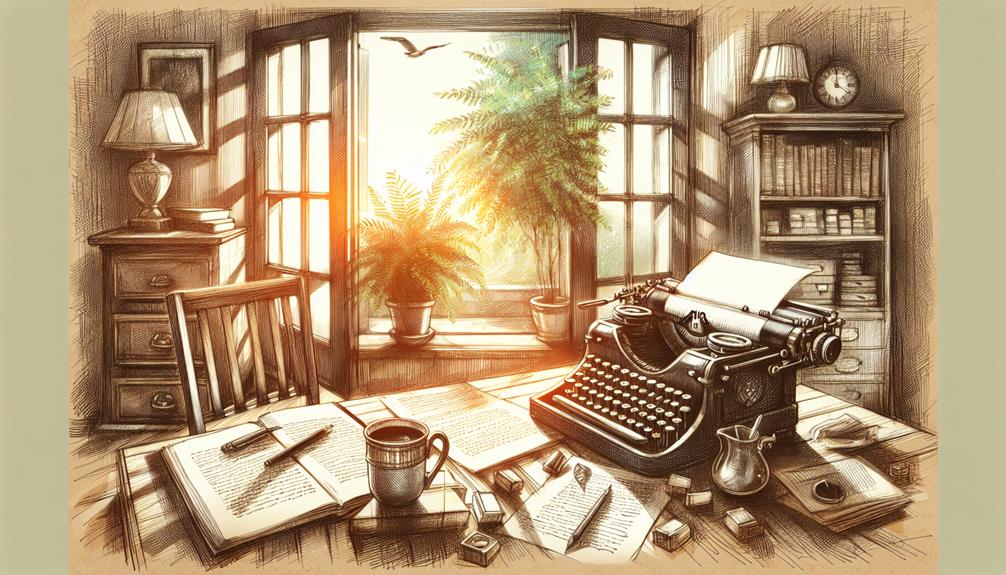When I write using modal verbs like 'can', 'should', or 'must', I'm really tweaking the verb to express necessity or possibility. These little helpers are right next to the main verb in a sentence, helping to spice up what I'm trying to convey. It's not just about grammar; it's about setting the right tone, whether in daily conversation or formal writing. If you're looking into modal music, the concept kind of shifts to focusing on tonal centers and characteristic notes that give each piece its unique flavor. Stick around, and I'll show you some more cool stuff about modals in both language and music!
Table of Contents
Key Takeaways
- Identify the tonal center and characteristic note of the chosen mode for your composition.
- Use one-chord vamps to emphasize the mode's unique flavor and mood.
- Incorporate modal interchange to introduce chords from different modes, enriching the tonal variety.
- Focus on crafting melodies and bass lines that highlight the characteristic notes and deepen modal expression.
- Experiment with modal chords that stress the special notes and qualities of the mode for a cohesive sound.
Understanding Modal Basics
To really get the hang of modal verbs, you've got to understand that they tweak the main verb in a sentence to express things like possibility or necessity. These little helpers are the backbone of flexible and nuanced communication in English. They're not just some fancy grammar term; they're practical tools that shape how we convey our thoughts and instructions.
Modal verbs, like 'can', 'will', 'must', and 'should', always stick close to the main verb, usually in the infinitive form without 'to'. For example, in the sentence 'She can swim,' 'can' is the modal verb modifying 'swim' to show ability. Similarly, in 'You must try,' 'must' changes the verb 'try' to express an obligation.
Grasping how these verbs shift the meaning of the main verbs allows you to play with the subtleties of English. Whether you're suggesting, commanding, or permitting, modal verbs are your go-to. They're particularly handy in professional writing or everyday conversation where the right degree of formality and tone is crucial. So, mastering modal verbs isn't just about knowing them; it's about using them effectively to communicate exactly what you mean.
Identifying Tonal Centres
So, let's get into how we can spot tonal centers in modal music.
I'll start by looking at some common mode examples to see how they're structured.
Then, we can break down how pitch collection analysis helps us understand these patterns better.
Explore Common Mode Examples
Let's dive into some common modal examples to better understand how tonal centers shape music. Identifying these centers is key to mastering modal compositions. Here's a quick breakdown:
- Dorian Mode: Picture a piece centered on D. Its tonal center is D, making it sound stable yet a bit mysterious compared to a major scale.
- Phrygian Mode: Centered on E, it gives off a darker, more exotic vibe. The tonal center, E, anchors this mood.
- Lydian Mode: Focused on F, and with a raised fourth, the tonal center here makes the music sound brighter and more uplifting.
Grasping these centers is crucial for nailing the modal approach in your music creations.
Utilize Pitch Collection Analysis
Diving into pitch collection analysis helps us pinpoint the tonal center in a piece, which is key for understanding its harmonic structure.
When we talk about modal music, this becomes super important. The tonal center, or the strongest note, gives each mode its unique color and feel.
If you're handling atonal music, though, it's a different ball game—there's no clear tonal center, which can make the music feel kinda ambiguous and unpredictable.
Defining Tonic Chords
Tonic chords are the heart of a song's harmony, acting as the musical piece's stable home base. They're what everything else in your track will revolve around. When I'm writing, especially in modal music where the feel and color are so distinct, nailing down that tonic chord is crucial. It sets the vibe and gives every other chord a reference point.
Here's what you gotta know about tonic chords:
- Stability and Resolution: Tonic chords give your music a sense of completion. After all the tension and release in your song, landing on the tonic chord feels like coming home. It's satisfying and rounds things off neatly.
- Framework for the Key: These chords determine the key of your music. Whether you're working in a major or minor key, or getting creative with modal chords, your tonic chord lays the foundation. It's like setting the rules of the game before you start playing.
- Simplicity in Structure: Typically, tonic chords are straightforward, often built from two or more notes stacked in thirds. This simplicity is key to their stability, making them a strong starting point for any composition.
Understanding tonic chords isn't just theory; it's your toolkit for building compelling, grounded music.
Characteristic Notes Exploration
Why should we pay attention to the characteristic notes in each mode? Well, these notes aren't just random; they're the secret sauce that gives each mode its unique flavor. Think about it like this: every mode in the major scale has this special note that makes it stand out. When you're composing, hitting these notes in your progressions can really define the mood and tonality of your piece. It's what makes modal music, well, modal!
Let me break it down—say you're working with the Dorian mode. Its characteristic note adds a kind of jazzy feel to the music that you won't get with other modes. And that's just one example! Each mode has its own vibe, and knowing which note gives off that vibe is key to mastering modal composition.
Crafting One Chord Vamps
Now, let's talk about how modal harmony and vamp composition techniques play into crafting one chord vamps.
It's all about choosing the right chord and tweaking it to set the mode's vibe.
We'll look at how these elements combine to create a compelling musical foundation that's both simple and expressive.
Exploring Modal Harmony
Let's dive into how modal harmony uses one-chord vamps to highlight a mode's unique flavor. By zeroing in on the characteristic note, these vamps really let the mode's personality shine through. Here's how I approach it:
- Focus on the Characteristic Note: I always start with the tonic chord and weave in the mode's standout note. This isn't just any note—it's the heart of the mode's mood.
- Melody and Bass Line Interaction: I play around with how the melody and the bass line interact, making sure they emphasize the modal sound without stepping on each other's toes.
- Chord Tension: Adding tension notes to the chord helps in coloring the vibe, keeping it fresh and engaging.
Vamp Composition Techniques
Having explored modal harmony, I'll show you how to craft effective one-chord vamps. Start by picking a chord that matches the mode you're aiming for. For instance, a D-7 chord sets up a Dorian feel, while an FMaj7 chord leans into Lydian vibes. It's all about that characteristic note; it's gotta pop to define the mode.
Next, mix in a catchy melody and a groovy bass line. These elements should highlight your chosen mode's unique flavors. Don't forget to play around with chord tensions too—they can really spice things up.
Experimentation is key. Try different notes and see how they change the vibe. It's all about finding that perfect sound that hooks your listeners right in.
Developing Modal Chord Sequences
To kick off with developing modal chord sequences, you'll need at least two chords: the tonic and another that highlights the mode's unique note. Modal chords aren't just any chords; they've got to fit neatly within the mode's scale to nail that modal vibe. You're not just playing chords; you're painting with sound, using tones that bring out the flavor of the mode.
Here's how I go about it:
- Identify the Tonic: This is your home base. Say you're working in Dorian mode on D, your tonic is a Dm chord.
- Find the Characteristic Chord: Look for chords that use the mode's unique note. For D Dorian, it's the natural sixth, which is a B. So, a G major could be your next go-to since it packs that B.
- Experiment and Refine: Play around with these chords. Switch orders, add a pass-through chord, or throw in modal interchange (yep, that's using chords from other modes but same tonic). Keep what vibes best.
Distinguishing Pure Modal Music
Distinguishing pure modal music is all about sticking strictly to one mode for both melodies and harmonies. When you're deep into writing this kind of music, you can't just mix and match from different modes willy-nilly—that's a whole other ball game. It's like using modal verbs in language; you choose one to set the mood or tone and stick with it to keep things consistent.
When I create pure modal music, I dive into one mode—let's say Dorian. Every note in my melodies and every chord in my harmonies has to come from Dorian. This isn't just about slapping together some notes that sound good; it's about evoking specific emotions and maintaining a consistent sonic environment that truly reflects the character of the mode.
This approach sets pure modal music apart from regular tonal music, where you might shift key centers or borrow chords from other keys. Here, the vibe is more stable, but also unique because each mode brings its own flavor and mood. It's an exploration of tonality within a fixed framework, which can be super rewarding if you're looking to master different musical textures and emotional impacts.
Exploring Modal Interchange
Let's dive into modal interchange, a technique that spices up music by mixing chords from different modes. It's about grabbing chords from parallel modes to add unexpected twists and turns in your compositions. This isn't just about novelty; it's a strategic move to deepen the emotional and tonal palette of your music.
Here's what you gotta know about modal interchange to master it:
- Borrowing Basics: Start with understanding the modes—Ionian, Dorian, Phrygian, and so on. Each has its unique vibe. Modal interchange lets you borrow chords from these modes even if they don't traditionally belong in the key you're working in.
- Enhanced Emotion: By introducing chords from different modes, you can dramatically alter the mood of a piece. A major progression can suddenly dip into a minor feel, pulling at the listener's emotions more effectively.
- Creative Progressions: This technique breaks you out of the rut of predictable patterns. By mixing modes, you can create fresh and innovative chord progressions that stand out.
Utilizing Characteristic Modal Chords
Building on modal interchange, we now explore how characteristic modal chords can shape the unique atmosphere of your music. These chords aren't just any chords; they're your secret sauce. They grab that one note that makes a mode stand out and put it right where everyone can feel it.
So, what does this mean for your tracks? Well, by focusing on those diatonic chords that highlight the mode's special note, you're essentially painting with a richer palette.
Let's say you're dabbling in Dorian mode. You want to spotlight that raised sixth—it's what gives Dorian its slightly melancholic edge. You could lean on a chord like B minor in a progression in D minor to bring that out. This isn't just about sticking to formulas; it's about knowing the rules so you can bend them creatively.
Experimenting with these modal chords opens up a playground for texture and emotion. It's about more than just the notes; it's how you use them. Think of these chords as modal verbs—they add mood, tense, and voice to your musical sentences. Crafting songs with this toolset lets you communicate more precisely what you feel, setting your music apart.
Frequently Asked Questions
How Do You Write a Modal Melody?
I start by picking a mode like Dorian, then focus on its unique note to shape my melody. I play around with scale intervals and phrases to bring out that mode's vibe.
What Makes a Song Modal?
A song's modal when it sticks to a specific mode like Dorian or Lydian, focusing on the characteristic notes and tonal center that give it a unique mood and sound. That's the key!
How Do You Write in a Mode in Music?
To write in a mode, I focus on its characteristic note and use chords that highlight this feature. I experiment with modes like Dorian or Lydian to create unique moods in my music.
How Do You Play the Modal?
When I play modal, I focus on the mode's unique note and use diatonic chords that highlight it. I keep the progressions simple and explore different modes to spice up my music.
- The History and Evolution of Chamois Fabric - June 22, 2025
- Chamois Fabric on Wikipedia: What You Need to Know - June 22, 2025
- How to Pronounce Chamois Fabric Correctly - June 22, 2025







